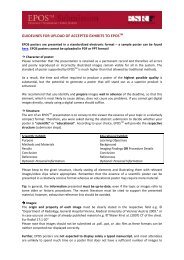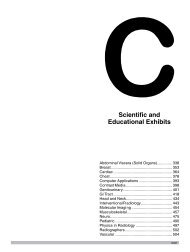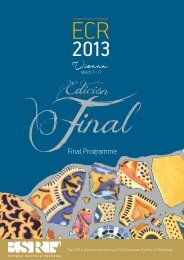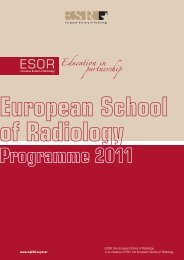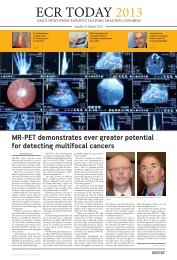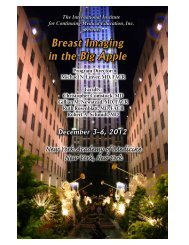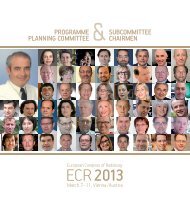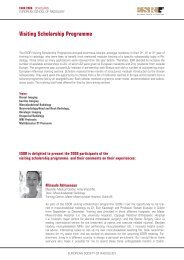Scientific - myESR.org
Scientific - myESR.org
Scientific - myESR.org
- No tags were found...
You also want an ePaper? Increase the reach of your titles
YUMPU automatically turns print PDFs into web optimized ePapers that Google loves.
EUROPEAN CONGRESS OF RADIOLOGY 2011 | www.myesr.<strong>org</strong><br />
CT’s unrivalled<br />
success poses<br />
dilemmas in<br />
thoracic emergencies<br />
By Philip Ward<br />
Sunday, March 6,<br />
16:00–17:30<br />
SF 14<br />
Thoracic emergencies:<br />
triage with MDCT<br />
Should you insist that every request for an emergency CT scan is screened for its<br />
appropriateness Should you refuse to perform CT scans without a proper indication,<br />
risking the anger of your referring colleagues And how can you manage appropriateness<br />
effectively<br />
There are no easy answers to these three urgent questions facing radiologists, but those<br />
who attend the special focus session on thoracic emergencies at ECR 2011 will no doubt<br />
be much better informed about the issues.<br />
In many countries, imaging in the emergency department is not solely based on<br />
appropriateness but also on defensive medicine, finances, and politics, according to session<br />
moderator Dr. Digna R. Kool, from the department of diagnostic imaging, University<br />
Medical Centre Nijmegen, The Netherlands, who will moderate the session. Because of fear<br />
of missing a significant diagnosis, some clinicians request an imaging examination even<br />
when it is in conflict with accepted clinical decision rules and evidence in the literature.<br />
Furthermore, if CT is reimbursed fully under an insurance-based healthcare system, it will<br />
be in the interests of the hospital – and of private practice radiologists – to perform CT.<br />
“In many countries, politics rule, and it could be a great PR message for administrators<br />
to stress the fact that they offer the best method to exclude potentially life-threatening<br />
diseases, although we do not have enough evidence in this field yet,” she said.<br />
Kool thinks all radiologists should brush up on their knowledge of acute chest pain<br />
because the number of requests for imaging in these patients is rising fast and it is often<br />
encountered during on-call work. Part of the increase in requests for multidetector<br />
CT (MDCT) in acute chest pain is appropriate because technical advances have led to<br />
significant increases in diagnostic opportunities, resulting in faster and more accurate<br />
diagnoses and more effective clinical decision-making.<br />
Clinicians use MDCT to decide if patients need treatment and whether they should be<br />
admitted to hospital or can be discharged from the emergency department. Early discharge<br />
can decrease hospital costs significantly, she stressed. However, MDCT has important<br />
drawbacks, including costs and radiation, and with the increasing use of MDCT, the yield<br />
in positive results is decreasing.<br />
24




